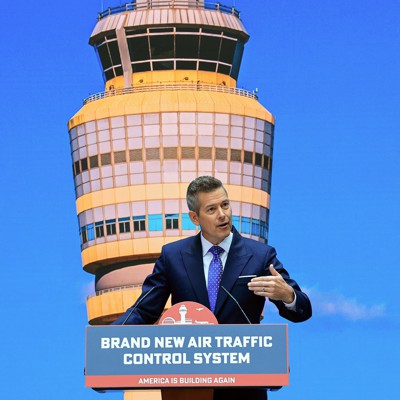The Transportation Department is undertaking a massive effort to modernize the nation’s outdated air traffic control system, with the agency’s head announcing on Thursday that he hopes to complete the overhaul within the next four years.
Transportation Secretary Sean Duffy unveiled the plan at the department’s D.C.-based headquarters during an event that featured a slate of bipartisan lawmakers, top agency officials and leading representatives from the travel industry and related advocacy groups.
Duffy said the modernization initiative includes several brick-and-mortar components — such as rebuilding some air traffic control towers — but that “everything else that controls the airspace is going to be brand new.”
The approach he outlined heavily focuses on the adoption of new technologies, including replacing antiquated telecommunications networks with fiber optics, deploying a modernized flight management system, implementing new radios for air traffic controllers and installing ground radar systems at U.S. airports.
Duffy likened the current air traffic control technologies to flip phones, adding that “you can’t build anything on top of the system that we now use.” He said, however, that adopting newer iPhone-like tech means that “you can actually get updates” and that you can then “build on top of what we have in place.”
To complete the plan, Duffy set forth an ambitious timeframe that he said is largely dependent upon the support of federal lawmakers.
“I can’t do it by myself, and it’s going to take the help of the Congress to make that happen,” he said, adding that “to do it in three or four years, we need all of the money up front.”
The House Transportation and Infrastructure Committee approved a budget reconciliation proposal on April 30 that set aside $12.5 billion for modernizing air traffic control technology. In a press conference following the event, however, Duffy said the total cost of the plan is “gonna be more than that.”
“I want the Congress to work its magic,” Duffy said, adding that he plans to work with lawmakers on the details rather than giving them a specific amount.
President Donald Trump called into the event and also spoke to the attendees via speakerphone, telling the audience that he hopes to have “one big, beautiful contract for everything,” and that he and Duffy are soliciting feedback about which firm “has the best system.”
“We’re negotiating with the various companies now, so we’d like your recommendation,” Trump said.
Duffy expanded on the president’s remarks during the press conference and said officials are “working through current contracts and how we navigate, how we move forward, but a lot of the current providers are going to be part of what we’re going to do.”
He added that they would likely have “one contractor to be responsible for all the [subcontractors] and the coordination between all the subs.”
Thursday’s announcement comes in the wake of mounting accidents and safety concerns at U.S. airports.
Last week, an outage at Newark Liberty International Airport in New Jersey caused air traffic controllers to lose communications with flights for roughly 90 seconds. In January, an Army Black Hawk helicopter and a commercial airliner near Ronald Reagan Washington National Airport collided in midair and killed all 67 people on both aircraft. Some of the families of those killed in the crash attended Thursday’s event.





